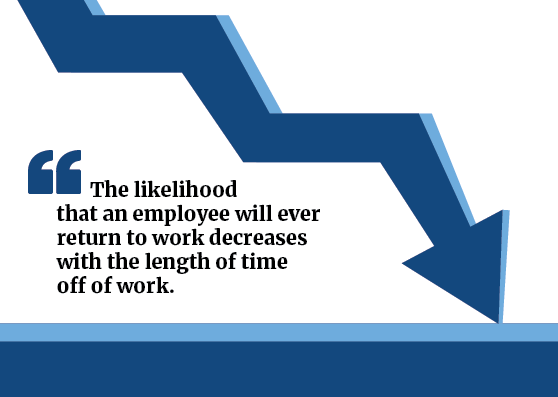
An on-the-job injury is a scary thing for both the employee and the company. Both are concerned about the extent of the injury and the costs. There are actions a company can take to not only assist their employee, but also keep costs as low as possible. Those actions are important so that the injured party doesn’t feel the need to engage the services of a lawyer.
When an attorney becomes involved in a workers’ compensation claim, costs go up. For example, benefit and expense payments for temporary disability claims with an attorney average $30,319 versus $5,598 for those without. Payments for permanent disability claims with an attorney average $66,208 versus $25,300 for those without.
Attorneys will usually take home 30 percent of the settlement paid to the claimant. Inflating the value of the claim means an increase in pay. The attorney may direct a patient to a specific doctor in order to influence treatment or extend the length of medical treatment. The attorney’s preferred doctor may increase work restrictions making return-to-work more difficult. Additionally, there are legal costs associated with representation including travel, time, court reporters, mediators, subpoenas and more.
Why do workers feel the need for an attorney? They are anxious, afraid and don’t know who to trust. Those feelings arise because the injured party may think no one is working on their claim or that their claim will be denied. They are concerned about receiving medical treatment or medications, possible surgery and mounting medical bills. They may be afraid of being terminated by their employer or being so injured they cannot return to work. That leads to fear of not being able to pay their bills.
Most concerns come down to a lack of communication between the worker and the employer. Other issues can be tied to behaviors of the employer which create an adversarial relationship between the employer and the employee.
If one of your workers is injured you can help the process by:
- Promptly reporting the claim with your insurance carrier
- Sharing insurance information with the injured employee
- Maintaining consistent behavior towards the employee after reporting a claim
- Letting your insurance carrier determine if the claim is valid
- Bringing the employee back to work following a claim
- Offering light or modified duty for your employees
Protective has processes in place to help employers maintain a good relationship with their injured employee. Each claim is put through an internal triage process to make sure the most appropriate adjuster is assigned to that claim. We take into consideration the type of injury, jurisdiction and any red flag indicators such as potential fraud and pre-existing conditions. Once assigned, three-point contact with the claimant, employer and medical provider is made within 24 hours. From there, Protective provides:
- Customer communication on a regular basis to provide proactive status reports, modified duty opportunities, litigation plans, surveillance consideration and claim resolution.
- Claimant contact on a weekly basis for the first eight weeks of disability, biweekly during weeks nine
through 16 and monthly contact until a successful return to work is achieved or the claim is settled.
- Supervisors review claims on day seven to confirm that three-point contact has been made and on day 15 to verify compliance with state filing and disability payment requirements. To ensure the claim is moving toward resolution, it is reviewed every 30 to 45 days thereafter by the adjuster and the unit supervisor.
- A nurse case manager triages all indemnity claims on day 14 to ensure medical management is progressing and every 30 days thereafter depending on the severity of the injuries.
- Compensability will typically be determined within 14 days.
Alternative Return-to-Work Program
Many employers either do not have light or modified duty available or do not want to bring claimants back into the workplace. Return-to-work programs benefit everyone involved through:
- Keeping employee’s active and more engaged
- Maintaining communication with the claimant and employer
- Reducing claim duration and costs
The likelihood that an employee will ever return to work decreases with the length of time off of work.
- Off one month = 90% likelihood of return
- Off six months = 50% likelihood of return
- Off 12 months = 5% likelihood of return
One option for a return-to-work program is available through ReEmployAbility and its Transition2Work Program. ReEmployAbility’s Transition2Work Program provides transitional employment with a nonprofit agency for an injured employee when the employer is unable to accommodate a temporary light duty work release. The Program:
- Bridges the gap between injured employees’ capabilities and employer’s ability to accommodate modified duty on-site
- Encourages faster recuperation and return to work while potentially reducing medical costs
- Promotes social responsibility, community outreach, and goodwill while exposing employee to meaningful work
- Helps avoid ‘disability syndrome,’ improves workplace morale, and retains a valuable employee
- Improves employee’s sense of value and self-esteem by reintroducing employee to work routine
- Reduces claim duration and costs which can significantly impact experience modification, reserves, and future premiums
Learn more about their Program at www.reemployability.com.
Sources: California Workers’ Compensation Institute, Bureau of Labor Statistics, American Society of Safety Engineers, A Physicians Guide to Return to Work